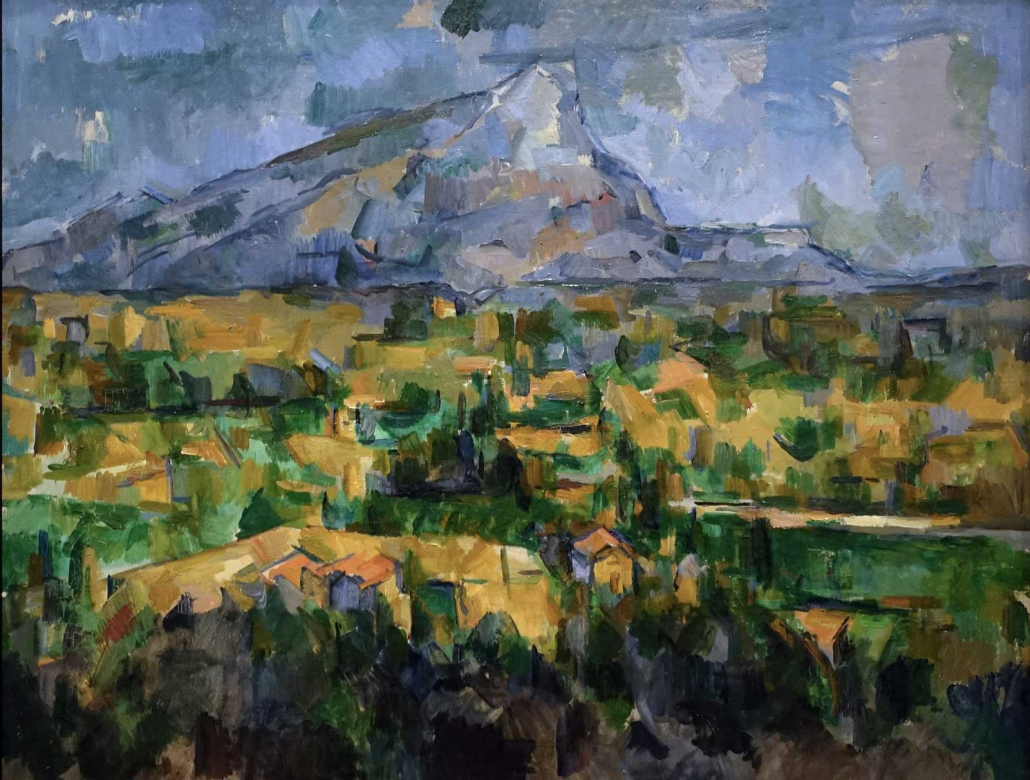Image: Paul Cézanne, ‘Mont Sainte-Victoire’, 1902–04, oil on canvas, 73 x 91.9 cm (Philadelphia Museum of Art, photo: Steven Zucker, CC BY-NC-SA 2.0).
‘Flattening our mountains and filling in our hollows’
Bible study prepared by Andrew
October 2022
Thursday October 13, 7-8.30pm.
All welcome. At the manse or via Zoom.
Join Zoom Meeting
Meeting ID: 858 1336 0721
Passcode: 032351
Key text: Isaiah 40:1-4
Themes: Exile, homecoming, consolation, renewal, intrinsic value and voice of Creation, eco-justice …
Readings
Isaiah 11:9; Psalm 24:1; Psalm 72:3; Luke 3:5
Introduction
The prophecy belongs to the second part of Isaiah, which begins with chapter 40 and ends with chapter 56. It may be called the Book of Consolation since the very opening words give us the keynote of the whole second part.
It is clear from the preceding and the subsequent chapters that the 40th chapter must refer to the Jewish liberation from the Babylonian exile. For such an announcement is naturally expected after chapter 39, and in the subsequent chapters the same event is described as coming to pass through the instrumentality of Cyrus. At the same time it cannot be denied that the prediction has also a messianic application (https://thedivinelamp.wordpress.com).
Background
The Babylonian captivity or Babylonian exile is the period in Jewish history during which a large number of Judeans from the ancient Kingdom of Judah were captives in Babylon, the capital city of the Neo-Babylonian Empire, following their defeat in the Jewish-Babylonian War and the destruction of Solomon’s Temple in Jerusalem. The event is described in the Hebrew Bible, and its historicity is supported by archaeological and non-biblical evidence.
After the Battle of Carchemish in 605 BCE, the Babylonian king Nebuchadnezzar II besieged Jerusalem, which resulted in tribute being paid by the Judean king Jehoiakim. In the fourth year of Nebuchadnezzar II’s reign, Jehoiakim refused to pay further tribute, which led to another siege of the city in Nebuchadnezzar II’s seventh year (598/597 BCE) that culminated in the death of Jehoiakim and the exile to Babylonia of his successor Jeconiah, his court, and many others; Jeconiah’s successor Zedekiah and others were exiled when Nebuchadnezzar II destroyed Jerusalem in his 18th year (587 BCE), and a later deportation occurred in Nebuchadnezzar II’s 23rd year (582 BCE). However, the dates, numbers of deportations, and numbers of deportees vary in the several biblical accounts.
After the fall of the Neo-Babylonian Empire to the Achaemenid Persian Empire and its founding king Cyrus the Great at the Battle of Opis in 539 BCE, exiled Judeans were permitted by the Persians to return to Judah. According to the biblical Book of Ezra, construction of the Second Temple in Jerusalem began in c. 537 BCE in the new Persian province of Yehud Medinata. All of these events are considered significant to the developed history and culture of the Jewish people, and ultimately had a far-reaching impact on the development of Judaism.
Archaeological studies have revealed that, although the city of Jerusalem was utterly destroyed, other parts of Judah continued to be inhabited during the period of the exile. Most of the exiled did not return to their homeland, instead travelling westward and northward. Many settled in what is now northern Israel, Lebanon and Syria. The Iraqi Jewish, Persian Jewish, Georgian Jewish, and Bukharan Jewish communities are believed to derive their ancestry in large part from these exiles; these communities have now largely immigrated to Israel (Wikipedia).
An eco-feminist reading
How does the text enable violence to mountains, valleys, Earth communities?
How might the text offer resistance to exploitation and violence?
“ … to rethink human relationships in a more-than-human framework of interconnectedness, interdependence and material co-agency” (Anne Elvey).
Smoothing out of difference between two categories (valley and hill) to create a third category (plain).
“Entire mountaintops are blown up, cut up and ground into dust as the coal is extracted. The rubble left over is dumped into nearby valleys – obliterating hundreds of mountain streams” (Anne Elvey).
“The dynamism of the valleys and hills … affirming and in conversation with the liveliness of the mountains, valleys and their communities subject to MTR [mountaintop removal mining], stands in contrast to the homogenising ethos of capitalist extractivism” (Anne Elvey).
“[C]limate change exposes the unliveability of a world sustained by coal” (C. Parker Krieg).
“You are flattening our mountains and filling in our hollows, and this is the last evil you will do” (Denise Giardina).
“The Earth body … needs an ‘eco-medicine’ that takes into account biological-ecological, anatomic-geographic, cultural, philosophical and spiritual dimensions in complementary ways” (Angelina Paredes-Castellanos and Ricardo Rozzi).
Lunar landscape … communities in conflict …
“Somehow I doubt that bulldozers and bombs, wasted lives and throwaway landscapes are the means of the revealing of God’s glory” (Norman Wirzba).
The level road parodies Babylonian hymnody. Isaiah 40 offers relief. Covenant = land, people, God.
A call to valley, hill and mountain to respond to the cry, to participate in the preparation of this thoroughfare for the divine.
“The imagery suggests that valley and mountain share both the exaltation (or attitude of praise/lifting up) and the humility summoned, when the presence or glory of YHWH is revealed” (Anne Elvey).
Luke 3:5 replays Isaiah 40:4, echoes theme of renewal.
“The mountains and valleys themselves are by extension not only resources for metaphors or mining, but also participants in the Isaian and Lukan worlds of divine interactivity” (Anne Elvey).
“The liveliness of valley and mountain – the liveliness of the particular landscape that YHWH, Cyrus and returning exiles might encounter on their way to Jerusalem – is prior to the road-building metaphor it supports” (Anne Elvey).
People embedded in their land respond to the death-dealing of a land treated as if inert and rendered passive …
Affirming the relational liveliness (and material agency) of the Appalachian mountains as more-than-human communities …
Calls to mind the trails of tears of the Cherokee people, their removal from Appalachia and determination to survive.
“Resistance and protest need to be balanced with radical reverence and wonder, attendant on the elegance, astonishing diversity and complexity of life forms, entangled materiality, and stunning beauty of planetary beings and processes” (Anne Elvey).
“Embedding more-than-human resistances in open-spirited attention to the deep time conversation of mountains, atmosphere, seas and their inhabitants … an essential ethic and aesthetic for an ecological feminist hermeneutics” (Anne Elvey).
Artwork
Image: Paul Cézanne, ‘Mont Sainte-Victoire’, 1902–04, oil on canvas, 73 x 91.9 cm (Philadelphia Museum of Art, photo: Steven Zucker, CC BY-NC-SA 2.0).
‘Cézanne picked up a box in the hall [of his studio] and took me to his motif. It was two kilometers away with a view over a valley at the foot of Sainte-Victoire, the craggy mountain which he never ceased to paint … He was filled with admiration for this mountain’ (Emile Bernard).
Three aspects of religion (three approaches to reading)
- Poetics (What qualities of language or expression do we notice? Are there key words, phrases or images? What is the tone or feeling of the text?)
- Ethics (Whose calls for help, whose calls to justice do we perceive? How will we respond?)
- Metaphysics (Are we offered insights regarding the world? How might we describe or come to experience this world we live in?)
JANE: Isaiah 40 is one of my favourite chapters in the Bible. I find it so encouraging and hopeful. I love to read the whole chapter.
PAMELA: The theme of homecoming is very rich. I think of refugees and their hopes of returning home … their love for a home country. I also think about end-of-life prayers, death as a kind of homecoming. That doesn’t worry me at all. It’s actually comforting to think about dying in terms of going home.
NORRIE: The hills are alive with the sound of music!
ABNER: Indigenous spirituality is actually very similar to Christian spirituality – if we imagine things in an ecological way. God is present in the mountains and valleys, everything is capable of change and new life.
ANDREW: Spirituality leads back to very real needs and concerns in the world. Making a path for God, or the Messiah, means tending the Earth and loving the world around us – and within us.
Songs
‘Peace in the Valley’ by Elvis Presley (1957)
‘Thunder on the Mountain’ by Bob Dylan (2006)
‘Cherokee’ by Cat Power (2012)
Never knew love like this
The wind, the moon, the earth, the sky
Sky so high
Never knew pain like this
Everything die, then die
Never knew love like this
The sun, the sea, you and I (you and I)
Never knew pain, never knew shame
Now I know why
Bury me, marry me to the sky
Marry, marry me to the sky
If I die before my time
Bury me upside down
Cherokee, kissing me
When I’m on my way down
If I die before my time
Bury me upside down
Cherokee, kissing me
When I’m, I’m going down
Never knew love like this
The wind, the moon, the earth, the sky
Sky so high
Never knew pain like this
Everything die, then die
Never knew love like this
The sun, the sea, you and I (you and I)
Never knew pain, never knew shame
Now I know why
Bury me, marry me to the sky
Marry, marry me to the sky
If I die before my time
Bury me upside down
Cherokee, kissing me
When I’m on my way down
If I die before my time
Bury me upside down
Cherokee, kissing me
When I’m going down
If I die before my time
Bury me upside down, down
Cherokee, kissing me
When I’m on my way down
Cat Power, Sun
Chan Marshall, 2012.




